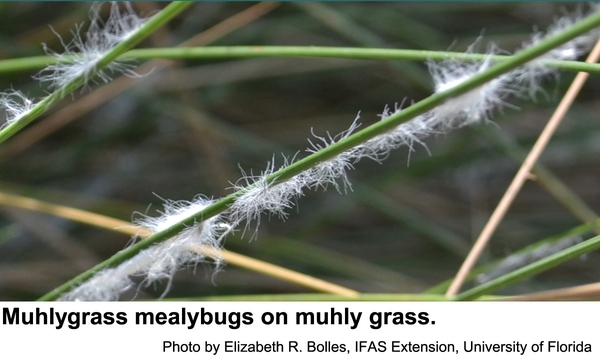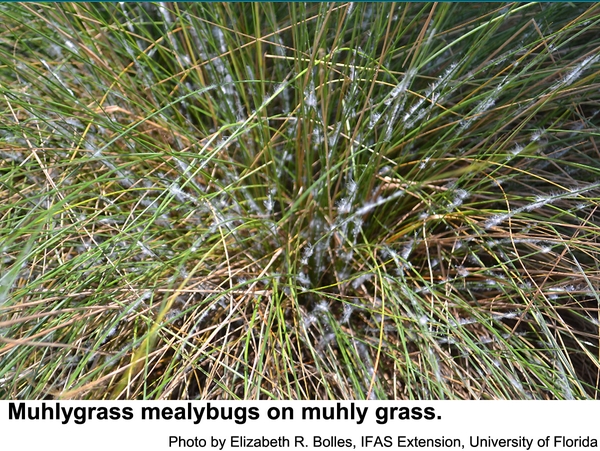Description and Biology
Female muhlygrass mealybugs, Stemmatomerinx acircula, are slightly less than 1/8 inch long, gray, and covered with short, dense, white fluff as well as numerous slender white filaments some of which are twice as long as the body (Figure 1). The body is relatively slender (2½ times as long as wide). Not much is known about its life history. Female mealybugs can travel short distances by crawling or they can be carried by ants. Because they lack wings, females must be transported to the proximity of the next host plant. Females lay their eggs into densely-packed, white, felt-like ovisacs on the leaves. Sometime later, crawlers hatch and eventually find their way to leaves where they insert their almost microscopic, hair-like mouthparts in and suck out the sap. Crawlers molt into nymphs that grow and molt three more times before molting into adults. Males are known for other species in this genus so it is likely muhly grass mealybugs have males too. Male mealybug nymphs each secrete a tiny, fluffy cocoon and develop into tiny, two-winged, four-eyed adults. Males fly about seeking females to mate with but soon perish (no mouthparts!). Muhlygrass mealybugs are native to Florida. It was first found in South Carolina in 2018 and now (2022) has been found in North Carolina. Our warming summers may be encouraging their populations to move north or they may have been brought into North Carolina on infested nursery stock grown further south.
Host Plants
Muhlygrass mealybugs infest muhly grass and perhaps fakahatchee grass. Heavy infestations cause plants to decline in vigor and to become off color (Figure 2).
Residential Recommendations
Carefully inspecting plants before they are installed in a landscape is a good preventive practice. Removing and destroying plants that are heavily infested and noticeably declining is a drastic but effective method of controlling muhlygrass mealybugs. Using a systemic insecticide or horticultural oil spray helps keep plants looking more attractive. Horticultural oils are about as toxic to people and pets as peanut butter. These oils are available at most big box stores, garden centers, and nurseries. It may take two applications about 14 days apart to knock the population down to an acceptable level. A repeat spray is necessary because the eggs may be protected by the felt-like cover over the ovisac. One systemic insecticide, imidacloprid, is available in most big box stores for residential landscape pest management. (The active ingredients of all insecticides are listed on the front label usually in very small print close to the bottom.) A single treatment should give acceptable suppression for a whole growing season. Imidacloprid is sold as spray and granular formulations. Using a granular formulation is convenient, but unlike the spray applications, even when the mealybugs die, their fluffy secretions will be noticeable for weeks. Spraying at least mats down the fluff.
Other Resources
- A Taxonomic Study of the Mealybug Genus Stemmatomerinx (Homoptera: Coccoidea: Pseudococcidae). Howell, J. O. and D. R. Miller. 1976. Ann. Entomol. Soc. Amer. 69 (2): 345-361.
- Horticultural Oils for Ornamental Plants. Frank, S. et al. 2018. Entomology Insect Notes, NC State Extension Publications.
- Muhly Grass Mealybug. Tanner, C. and J. L. Crowder. 2019. Home and Garden Information Center, Clemson Cooperative Extension.
- Muhly Grass Pest. Bolles, B. 2016. IFAS Extension, University of Florida.
- Extension Plant Pathology Publications and Factsheets
- Horticultural Science Publications
- North Carolina Agricultural Chemicals Manual
- For assistance with a specific problem, contact your local Cooperative Extension Center.
This Factsheet has not been peer reviewed.
Publication date: Aug. 31, 2022
Reviewed/Revised: Oct. 3, 2022
Recommendations for the use of agricultural chemicals are included in this publication as a convenience to the reader. The use of brand names and any mention or listing of commercial products or services in this publication does not imply endorsement by NC State University or N.C. A&T State University nor discrimination against similar products or services not mentioned. Individuals who use agricultural chemicals are responsible for ensuring that the intended use complies with current regulations and conforms to the product label. Be sure to obtain current information about usage regulations and examine a current product label before applying any chemical. For assistance, contact your local N.C. Cooperative Extension county center.
N.C. Cooperative Extension prohibits discrimination and harassment regardless of age, color, disability, family and marital status, gender identity, national origin, political beliefs, race, religion, sex (including pregnancy), sexual orientation and veteran status.


